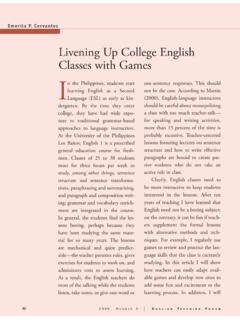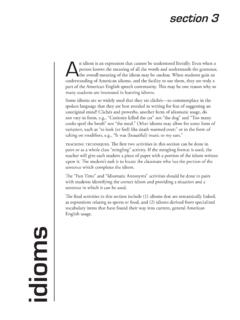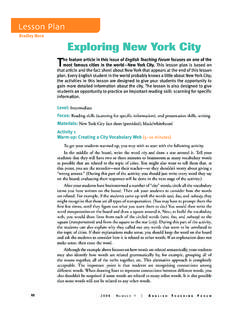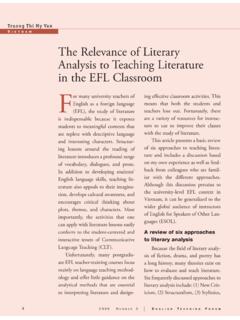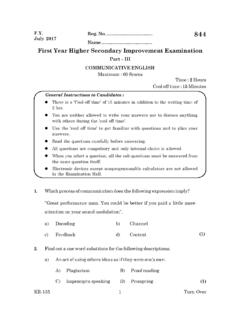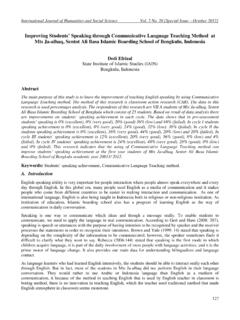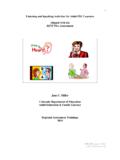Transcription of P o l a n d The Intercultural Approach to EFL …
1 102008 Nu m b e r 4 | En g l i s h TE a c h i n g Fo r u mZofia Chlopek Po l a n d The Intercultural Approach to EFL teaching and Learning nowadays, it is a widely known fact that teaching and learning a foreign lan-guage cannot be reduced to the direct teaching of linguistic skills like pho-nology, morphology, vocabulary, and syntax. The contemporary models of communicative competence show that there is much more to learning a lan-guage, and they include the vital com-ponent of cultural knowledge and awareness (Bachman 1990; Council of Europe 2001).
2 In other words, to learn a language well usually requires know-ing something about the culture of that language. Communication that lacks appropriate cultural content often results in humorous incidents, or worse, is the source of serious miscom-munication and misunderstanding. According to Kramsch (1993, 1), cul-ture is always in the background, right from day one, ready to unsettle the good language learners when they expect it least, making evident the limitations of their hard-won commu-nicative competence, challenging their ability to make sense of the world around them.
3 However, when writing or talking about teaching culture, theoreticians and practitioners often restrict them-selves to the specific culture of the target language. In English as a Sec-ond Language (ESL) contexts, where students live and are immersed in the culture of the English speakers, this may be a satisfactory Approach . But in English as a Foreign Language (EFL) settings, this is a very narrow view. In an EFL class, students are usu-ally monolingual and they learn Eng-lish while living in their own country (Krieger 2005). They have little access to the target culture and therefore a limited ability to become culturally competent.
4 Importantly, their aim for learning English is not only to com-municate with native speakers of Eng-lish but also with non-native speakers of English, which is why EFL learners are typically learners of English as an International Language (EIL). By learning English, EFL students are enabling themselves to become users of international, or rather intercultur-al, communication thus, the target language becomes a tool to be used in11En g l i s h TE a c h i n g Fo r u m | Nu m b e r 4 2008interaction with people from all over the world, where communication in English takes place in fields such as science, technology, business, art, entertainment, and tourism.
5 It is obvious then, that in order to successfully function in a culturally diverse environment, our learners need to develop Intercultural communicative competence (Alptekin 2002). This article will discuss the Intercultural Approach and pres-ent ideas and resources for English language teachers who wish to broaden their students multicultural awareness. Culture: A multidimensional concept The true complexity of what it means to know a language is revealed in the useful list of learner competencies produced by the Council of Europe (2001, 101 30).
6 In addi-tion to grammatical competence, a culturally competent learner must possess sociolinguistic competence, pragmatic competence, sociocul-tural knowledge, and Intercultural awareness. As can be seen, culture is a very broad con-cept, so to get to know a given culture means to gain extensive knowledge. It seems useful to make a distinction between the so-called big-C culture and small-c culture. The big-C part of a given culture is usually easy to study, as it constitutes factual knowledge about the fine arts such as literature, music, dance, painting, sculpture, theater, and film.
7 Small-c culture, on the other hand, comprises a wide variety of aspects, many of which are inter-connected, including attitudes, assumptions, beliefs, perceptions, norms and values, social relationships, customs, celebrations, rituals, politeness conventions, patterns of interaction and discourse organization, the use of time in communication, and the use of physical space and body language. Needless to say, language is also part of what we call culture, and it also reflects and interprets culture. Some of the small-c cultural aspects are directly observable, and hence easy to grasp and learn ( , celebrations and rituals).
8 However, many dimensions of a given culture are hidden from the eye. Here belong the small-c cultural aspects that, being imparted to us from birth, are deeply internalized and subconscious and are often noticed only in contrast with another culture. It is mainly these non-tangible cultural aspects that have an enormous influence on people s way of thinking and their linguistic/non-linguistic behavior and that, importantly, determine the expectations and interpretations of other peo-ple s linguistic/non-linguistic behavior. A per-son who encounters an unfamiliar culture will lack knowledge of such behaviors, which may lead to amusing situations, and even conflict, caused by miscommunication.
9 This happens because these aspects of culture are unspoken rules created by a community. Because these cultural rules are full of meaning and allow people to anticipate events, they often acquire a moral rigidity and righteousness that engen-der stereotypes and even prejudices (Kramsch 1995, 2). Let us consider a few examples of unsuc-cessful cross-cultural encounters. Such misun-derstanding of verbal or non-verbal messages often leads to the formation of a distorted picture of another society and its culture. A Polish person in the United States, after being offered a meal and refusing politely, could be unpleasantly sur-prised to be given nothing to eat, and might even think that Americans are stingy with food.
10 The American host would not realize that refusing food is a sign of modesty and the person offering the meal should insist. A German person having a meal with a Taiwanese family might feel highly dis-gusted if everybody at the table started belching, not realizing that this is a form of complimenting the cook. On the other hand, the Taiwanese family would probably perceive the German s behavior (lack of belching) as impolite. A Briton might be amused if a Polish person, on hearing the conventional greeting How are you? started com-plaining about her health; the Pole, on the other hand, would wonder why her interlocutor was amused.
